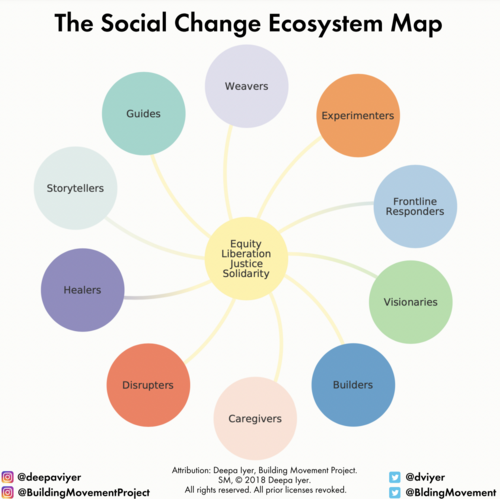Movement ecology
Movement ecology is a way of seeing each component of a movement as entering into a relationship with the other groups and individuals that are part of it. It is an invitation to see different strategies than the ones we use as assets for our movement.
The ideas and knowledge shared on this page come from:
1) An instagram live with Stu Basden, moderated by Kenzie Harris (HUB team member). Ideas coming from Stu are highlighted throughout.
2) Knowledge compiled by HUB franco librarian Isabelle Grondin Hernandez.
Instagram live speaker
|
Stu Basden (he/him): Stu is one of the ten co-founders of Extinction Rebellion, a globe-spanning social movement. Stu was one of the initiators of Toronto350.org, and was elected as President twice. He is a founding member of the Defend the Sacred Alliance and the Being The Change Affinity Network. He has facilitated hundreds of workshops, retreats and training courses around Europe and Turtle Island. |
It is inevitable that movements will be made up of people and groups who...
- Have different views of where the problem lies
- Have different ideas for solutions
- Take different actions to bring about the change they want to see.
Faced with this observation, the ecology of movements proposes to be part of this whole in a way to value the different contributions to our struggles, particularly in what is related to the different tactics.
Movement ecology relates to the concept of a diversity of tactics, first introduced by Malcolm X. In his speech, "The Black Revolution" he promoted solidarity between those who practiced armed resistance against racism, and those who practiced nonviolence. He stated, "Our people have made the mistake of confusing the methods with the objectives. As long as we agree on objectives, we should never fall out with each other just because we believe in different methods or tactics or strategy to reach a common goal." -Malcolm X [1]
“We have to recognize the validity of different actions, identify niches and try to fill them...And collaborate as much as possible. Social change is not a competitive market - this approach is opposed to what is needed to initiate transformational level change. - Thinking, doing, changing
Indeed, social movements are made up of groups fulfilling a multitude of roles. Recognizing these roles, building bridges and finding ways to use each group's contribution to the benefit of a movement can be the key to success. The struggle against imperialism in India offers an interesting case study.
Some of the main approaches to activism/organizing include:
| community organization (Structure-based organizing) |
mass organization (Movement-based organizing) |
the creation of alternatives (Prefigurative 'politics) |
Some of the main 'roles' groups can contribute to the movement, according to Bill Moyer [2] [3] include:
- The helper/citizen: focuses on direct service. Doing what they can in their own circles to support a cause.
- The advocate/reformer: focuses on communication with people who hold the power to change a policy or practice.
- The organizer/change agent: focuses on collecting masses of people who may not know each other. They use the power of numbers to force change on people in power.
- The rebel: focuses on making a commotion to force people in power to make a change.
Movement Mapping
When we say movement mapping we are talking about painting a portrait of the different groups that militate alongside us as well as the role or roles they fulfill. We draw a portrait of our activist community in order to better situate ourselves in it and realize the links that unite us. It is a question here of our reality on the ground, ecology being a broader concept encompassing many activist communities.
We begin by drawing a portrait of our group and its resources. Then, we can include mapping of our movement: the groups, our relationships with them, their approach/role and their resources as appropriate. The following is an example of a 'social change ecosystem' developed by Deepa Iyer from Building Movement Project:

If you have any suggested revisions or additional resources to share related to the above content, please email them to kenzie@lehub.ca.

- ↑ Malcolm X Speaks, George Breitman, ed. (Grove Press, 1994 edition), 46-49.
- ↑ https://commonslibrary.org/the-four-roles-of-social-activism/
- ↑ https://wagingnonviolence.org/2016/02/bill-moyer-four-roles-of-social-change